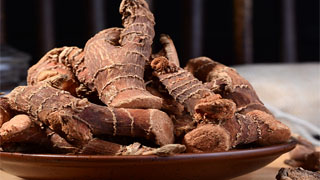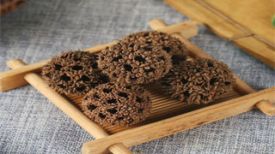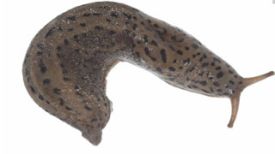
1. Alias
Xiao Liangjiang, Man Jiang, Qi Liang Jiang, Liangjiang, Buddha's Hand Root, Hai Liangjiang.
2. Plant morphology
Perennial herb, 30-120 cm tall. The rhizomes are cylindrical in shape, with a diameter of 1-1.5 centimeters, and have nodes with circular membranous scales at the nodes. They take root at the nodes and have a fragrant aroma. Leaves in two rows, linear lanceolate, 15-30 cm long, 1.5-2 cm wide, apex gradually pointed or nearly caudal, base gradually narrowed, entire margin or with indistinct dull teeth. The leaf sheath is open, embracing the stem, with a membranous edge. The leaf tongue can grow up to 3 centimeters long, membranous, gradually pointed, and brown. The inflorescence is apical, erect or slightly curved, measuring 5-15 cm in length. The axis of the inflorescence is covered with short hairs, and the bracteoles are narrow and round, persistent. The sepals are cylindrical, measuring 7-15 mm in length, with an uneven 3-lobed tip and short hairs on the outside. The corolla tube is about 1 cm long, with 3 lobes, rectangular in shape, and short hairs on the outside. The lip is oblong spoon shaped, light red, 2-2.5 cm long, with 1 stamen and about 1.6 cm in length. The filaments are linear, the ovary is lower, oval, covered with short hairs, 3-chamber, the style is slender, the stigma is slightly swollen, 2-lipped, and brown. The capsule is spherical, with a diameter of about 1.2 centimeters, orange red in color, and the seed has a dry false seed coat, blunt edges, and brown color. The flowering period is from April to October, and the fruiting period is from September to November.
3. Origin distribution
Born on roadsides, mountain slopes, and grasslands. Distributed in provinces and regions such as Guangdong, Guangxi, Hainan, Yunnan, and Taiwan, Guangdong has a large amount of cultivation.
4. Harvesting and processing
Harvesting in late summer and early autumn, removing fibrous roots and residual scales, washing, cutting into sections, and drying in the sun.
5. Characteristics of medicinal herbs
It is cylindrical, often curved, branched, 5-9 centimeters long, and 1-1.5 centimeters in diameter. The surface is brownish red to dark brown, with fine longitudinal wrinkles and gray brown wavy segments. The internodes are 0.2-1 centimeters long, and there are circular root scars on one side. Durable in texture, not easily broken, with a gray brown or reddish brown cross-section, fibrous, and a central column accounting for about 1/3. It has a fragrant aroma and a spicy taste.
6. Sexual Taste Returning to the Classics
Hot in nature, spicy in taste. Returning to the Spleen Meridian and Stomach Meridian.
7. Effect and Function
Warm the stomach and stop vomiting, dispel cold and relieve pain. Belonging to Wenli medicine.
8. Clinical application
Take 3-6 grams orally in decoction, or add pills or powder. Used to treat cold pain in the epigastric region, vomiting due to cold stomach, and acid swallowing due to belching.
9. Pharmacological research
Has antibacterial, analgesic, anti gastric ulcer, antidiarrheal, and choleretic effects; Can delay thrombus formation and inhibit platelet aggregation; Improve oxygen utilization capacity under low oxygen conditions.
10. Chemical composition
The rhizome contains various diphenylheptanes, flavonoids, and may also contain resveratrol and 7-hydroxy-3,5-dimethoxyflavonoids, as well as volatile oils. It also contains ingredients such as curcumin, dihydrocurcumin, hexahydrocurcumin, galangin, galangin-3-methyl ether, eugenol, brassinosteroid glucoside, stigmasterol glucoside, curcumin, dihydrocurcumin, methyl cinnamate, etc.
11. Usage taboos
Those with yin deficiency and heat are prohibited from taking it.
12. Compatibility prescription
① To treat heart and spleen pain: fine file high ginger, stir fry slightly, pestle finely. Mix 3 grams of rice drink. (The Ten Complete Directions)
② It can cure stomach cold, keep eating and vomiting: galangal, tangerine peel, etc. are divided into the end, and honey pills are as big as wutong seeds. Take a hollow pill. (Hygiene Easy Recipe)
③ To treat spleen and stomach deficiency, bloating and reflux: mix high ginger and wood fragrance with Luo powder. Take 3 grams of ginger powder and 1.5 grams of wood fragrance powder per serving. Boil one cup of water together until it reaches 70%, then add the mild residue and sip slowly. Do not use iron tools to fry without timing. (St. Francis of Assisi)
④ To treat cholera, vomiting, dysentery, and abdominal pain: 150g of high ginger (roasted and roasted), broken. Boil one liter of wine to three or four boiling points and take it all at once. (Emergency Response Plan)
⑤ To treat wind, cold, dampness, and pain in the waist and feet: divide high ginger and Fangji into powder, mash garlic and make cakes. Apply moxibustion to the painful area, with the degree of pain ranging from no pain to no pain, and from no pain to pain. (Surgical Masterpiece)
⊙ The content of the article is for clinical reference only. Non TCM professionals are not allowed to test drugs.


